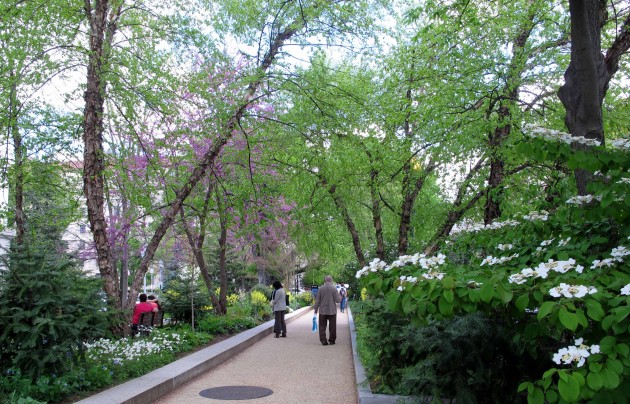By Chanel Williams

The Smithsonian Pollinator Garden on the grounds of the National Museum of Natural History. (Smithsonain Gardens photo)
Pollinators like butterflies, bees, beetles, flies, and moths help to pollinate almost 80 percent of the world’s flowering plants, one benefit of which is providing food for humans. Because their daily activities have such beneficial consequences for all life, it is important to make sure pollinators have places to rest, feed and reproduce.
James Gagliardi, lead horticulturist with Smithsonian Gardens at the Smithsonian’s National Museum of Natural History, says that the museum’s Butterfly Habitat Garden is setting the example by offering a balanced ecosystem for these pollinators right in the middle of Washington, D.C.
“Our garden offers butterflies a place to stop, pollinate, lay their eggs and get the rest they need,” Gagliardi says, pointing to the garden as a great example of how the Smithsonian is complying with the recent memorandum from President Obama asking federal buildings to make a concerted effort to be more pollinator friendly.

A black swallowtail caterpillar at the Smithsonian’s Pollinator Garden (Flickr photo by Sarah Erguren)
The Smithsonian has been making an effort to help pollinator populations for years, and continues to focus on helping educate the public about what they can do in their own backyard to attract and help pollinators.
“When people step into our garden they aren’t just getting to see the butterflies. We offer wonderful education panels so the average homeowner can produce the same pollinator-friendly spaces in their own yard,” Gagliardi says of the upgrades being made to the Butterfly Habitat Garden in anticipation of its upcoming name change to the Pollinator Garden. “The garden has always functioned as a pollinator garden. Now with the broad emphasis on supporting all pollinators we want our garden to reflect that commitment” Gagliardi says.
Gagliardi’s top three tips for creating a pollinator-friendly garden:
- Make sure that the garden offers a host source and a pollen source. There would be no butterflies or beetles to pollinate the different flowering plants if there are no caterpillars or larvae first. Make sure that the larvae or caterpillars’ essential food sources (for example, milkweed for monarch caterpillars) are available.
- Plant a variety of plants with differing flower shapes, colors, and bloom times to attract a diverse group of pollinators. Different pollinators have different methods of pollination. A variety of plants helps to give that pollinator the opportunity to find the plant that works best for them.
- Planting native species for that area in the garden is one of the most efficient and sustainable ways to support your local pollinators.






